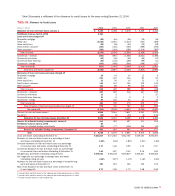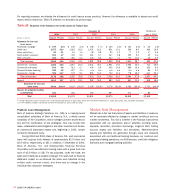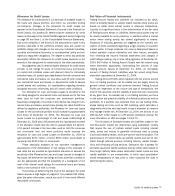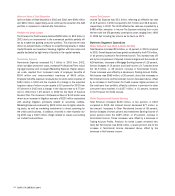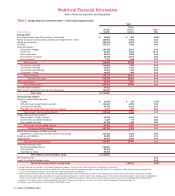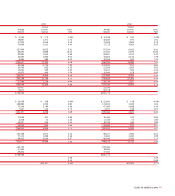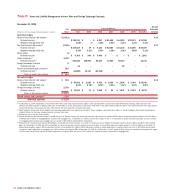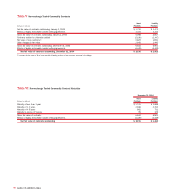Bank of America 2004 Annual Report Download - page 81
Download and view the complete annual report
Please find page 81 of the 2004 Bank of America annual report below. You can navigate through the pages in the report by either clicking on the pages listed below, or by using the keyword search tool below to find specific information within the annual report.
80 BANK OF AMERICA 2004
The fair values of Derivative Assets and Liabilities include
adjustments for market liquidity, counterparty credit quality, future
servicing costs and other deal specific factors, where appropriate. To
ensure the prudent application of estimates and management judg-
ment in determining the fair value of Derivative Assets and Liabilities,
various processes and controls have been adopted, which include: a
Model Validation Policy that requires a review and approval of quanti-
tative models used for deal pricing, financial statement fair value
determination and risk quantification; a Trading Product Valuation
Policy that requires verification of all traded product valuations; and
a periodic review and substantiation of daily profit and loss reporting
for all traded products. These processes and controls are performed
independently within the business segment. At December 31, 2004,
the fair values of Derivative Assets and Liabilities determined by
these quantitative models were $10.3 billion and $7.3 billion, respec-
tively. These amounts reflect the full fair value of the derivatives and
do not isolate the discrete value associated with the subjective valu-
ation variable. Further, they represent five percent and four percent of
Derivative Assets and Liabilities, respectively, before the impact of
legally enforceable master netting agreements. For the period ended
December 31, 2004, there were no changes to the quantitative mod-
els, or uses of such models, that resulted in a material adjustment
to the Consolidated Statement of Income.
AFS Securities are recorded at fair value, which is generally
based on direct market quotes from actively traded markets.
Principal Investing
Principal Investing is included within Equity Investments and is dis-
cussed in more detail in Business Segment Operations on page 50.
Principal Investing is comprised of a diversified portfolio of invest-
ments in privately-held and publicly-traded companies at all stages,
from start-up to buyout. These investments are made either directly
in a company or held through a fund. Some of these companies may
need access to additional cash to support their long-term business
models. Market conditions and company performance may impact
whether funding is available from private investors or the capital
markets.
Investments with active market quotes are carried at estimated
fair value; however, the majority of our investments do not have
publicly available price quotations. At December 31, 2004, we had
nonpublic investments of $7.0 billion, or approximately 96 percent of
the total portfolio. Valuation of these investments requires significant
management judgment. Management determines values of the
underlying investments based on multiple methodologies including
in-depth semi-annual reviews of the investee’s financial statements
and financial condition, discounted cash flows, the prospects of the
investee’s industry, and current overall market conditions for similar
investments. In addition, on a quarterly basis as events occur or
information comes to the attention of management that indicates a
change in the value of an investment is warranted, investments are
adjusted from their original invested amount to estimated fair values
at the balance sheet date with changes being recorded in Equity
Investment Gains (Losses) in the Consolidated Statement of Income.
Investments are not adjusted above the original amount invested
unless there is clear evidence of a fair value in excess of the original
invested amount. This evidence is often in the form of a recent trans-
action in the investment. As part of the valuation process, senior
management reviews the portfolio and determines when an impair-
ment needs to be recorded. The Principal Investing portfolio is not
material to our Consolidated Balance Sheet, but the impact of the
valuation adjustments may be material to our operating results for
any particular quarter.
Accrued Income Taxes
As more fully described in Notes 1 and 17 of the Consolidated
Financial Statements, we account for income taxes in accordance
with SFAS No. 109, “Accounting for Income Taxes” (SFAS 109).
Accrued income taxes, reported as a component of Accrued
Expenses and Other Liabilities on our Consolidated Balance Sheet,
represents the net amount of current income taxes we expect to pay
to or receive from various taxing jurisdictions attributable to our oper-
ations to date. We currently file income tax returns in more than 100
jurisdictions and consider many factors—including statutory, judicial
and regulatory guidance—in estimating the appropriate accrued
income taxes for each jurisdiction.
In applying the principles of SFAS 109, we monitor the state of
relevant tax authorities and change our estimate of accrued income
taxes due to changes in income tax laws and their interpretation by
the courts and regulatory authorities. These revisions of our estimate
of accrued income taxes, which also may result from our own income
tax planning and from the resolution of income tax controversies, can
materially affect our operating results for any given quarter.



